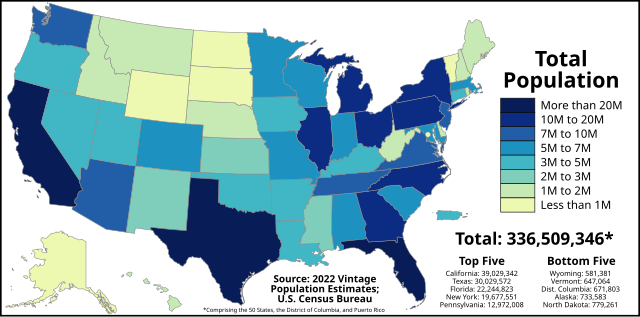Top Qs
Timeline
Chat
Perspective
List of U.S. states and territories by population
From Wikipedia, the free encyclopedia
Remove ads
The states and territories included in the United States Census Bureau's statistics for the United States population, ethnicity, and most other categories include the 50 states and Washington, D.C. Separate statistics are maintained for the five permanently inhabited territories of the United States: Puerto Rico, Guam, the U.S. Virgin Islands, American Samoa, and the Northern Mariana Islands.[1]


As of April 1, 2020, the date of the 2020 United States census, the nine most populous U.S. states contain slightly more than half of the total population. The 25 least populous states contain less than one-sixth of the total population. California, the most populous state, contains more people than the 21 least populous states combined, and Wyoming, the least populous state, has a population less than any of the 31 most populous U.S. cities.
Remove ads
Method
The United States Census counts the persons residing in the United States including citizens, non-citizen permanent residents and non-citizen long-term visitors.[2] Civilian and military federal employees serving abroad and their dependents are counted in their home state.[3]
Electoral apportionment
Summarize
Perspective
Every 10 years, the U.S. Census Bureau is charged with making an actual count of all residents by state and territory. The accuracy of this count is then tested after the fact, and sometimes statistically significant undercounts or overcounts occur. For example, for the 2020 decennial census, 14 states had significant miscounts ranging from 1.5% to 6.6%. While these adjustments may be reflected in government programs over the following decade, the 10-year representative apportionments discussed below are not changed to reflect the miscount.[4]
House of Representatives
Based on this decennial census, each state is allocated a portion of the 435 fixed seats in the United States House of Representatives (until the early 20th century, the apportionment process generally increased the size of the House based on the results of the census until the size of the House was capped by the Reapportionment Act of 1929), with each state guaranteed at least one Representative. The allocation is based on each state's proportion of the combined population of the fifty states (not including the District of Columbia, Guam, American Samoa, the Northern Mariana Islands, Puerto Rico, or the U.S. Virgin Islands).
Electoral College
The Electoral College, every four years, elects the President and Vice President of the United States based on the popular vote in each state and the District of Columbia. Each state's number of votes in the Electoral College is equal to its number of members in the Senate plus members in the House of Representatives.[5]
The Twenty-third Amendment to the United States Constitution additionally grants the District of Columbia (D.C.), which is not part of any state, as many Electoral College votes as it would have if it were a state, while having no more votes than the least populous state (currently, Wyoming). Since the U.S. Constitution guarantees every state at least one member of the U.S. House of Representatives and two members of the U.S. Senate, every state has at least three Electoral College votes. Thus, the Electoral College has 538 members (100 senators, plus 435 representatives due to the limit imposed by the Reapportionment Act of 1929, plus 3 members for the District of Columbia).[5] Territories of the United States are not included in the Electoral College: people in those territories cannot vote directly for the President of the United States,[6] although they may participate in the partisan nominating primaries and caucuses.[7]
Remove ads
State and territory rankings
Summarize
Perspective
* — non-voting member of the House of Representatives.
- Resident population only; does not include overseas population. In 2022, the Census Bureau announced the following undercounts (missed residents) in the 2020 census: Arkansas (−5.04%), Florida (−3.48%), Illinois (−1.97%), Mississippi (−4.11%), Tennessee (−4.78%) and Texas (−1.92%). These were the overcounts: Delaware (+5.45%), Hawaii (+6.79%), Massachusetts (+2.24%), Minnesota (+3.84%), New York (+3.44%), Ohio (+1.49%), Rhode Island (+5.05%) and Utah (+2.59%).[10]
- Effective from the 2022 elections onward. Each state has a number of votes in the Electoral College equal to its number of senators (two) and representatives in the Congress, while D.C. is granted three electoral votes. The Electoral College is used to elect the President and Vice President of the United States.
Remove ads
Summary of population by region
Summarize
Perspective
Column header abbreviations: # = Rank, Geo. = Geographic
Remove ads
See also
- Demographics of the United States
- List of U.S. states and territories by area
- List of U.S. states and territories by net migration
- List of U.S. states and territories by race/ethnicity
- List of U.S. states and territories by African-American population
- List of U.S. states and territories by historical population (tables of state populations since 1790)
- List of states and territories of the United States by population density
- List of U.S. states and territories by religiosity
- List of U.S. states by vehicles per capita
- List of United States cities by population
Remove ads
Notes
References
External links
Wikiwand - on
Seamless Wikipedia browsing. On steroids.
Remove ads
